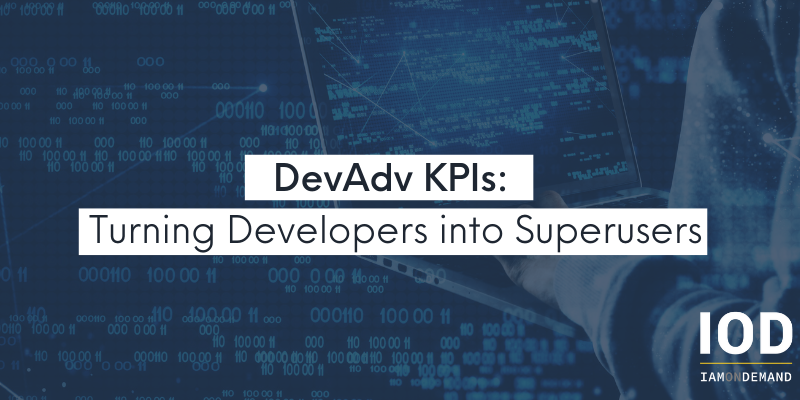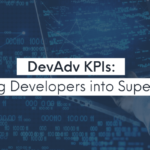Developer relations or developer advocacy—DevAdv for short—is an essential part of expanding your product’s reach, supporting new users, and helping decision-makers make informed choices about your solution.
Your developer advocates aim to accomplish the same overarching goal: to engage, acquire, and satisfy developers with a company’s product. These professionals are important liaisons between their company and external developers or stakeholders. Yet, since DevAdv teams have different goals across organizations, it can be unclear what successful developer advocacy looks like in action.
As a trusted advisor, developer advocates serve as a “North Star,” giving developers deeper insight into how to use a tool productively and independently. Yet, since tech solutions can differ dramatically, that means the key performance indicators (KPIs) that measure developer advocacy vary wildly, too.
Following years of experience as a developer advocate, Liaz Kamper—Senior Developer Advocate at AppsFlyer—has a unique insight into what makes a developer tick. He’s passionate about helping developers spend less time learning, implementing, and testing AppsFlyer’s code and more time using the tool to accomplish their goals. I recently sat down with Liaz, and he shared with me what KPIs make the difference when measuring developer advocacy.
Here are the KPIs Liaz recommends tracking for DevAdv success.
Creating Effective KPIs for the Developer Advocate
Defining success as a developer advocate depends on meeting developers, decision-makers, and users where they are and showing them how they can use your product to best accomplish their goals. However—despite DevAdv’s involvement in every stage of the sales funnel, implementation process, and beyond—it’s important to note that DevAdv’s job isn’t to sell your product.
“I’m not selling to developers. My job is not to convince developers to buy or even influence anyone buying the product,” Liaz says. “My job is to make sure their life is easier using the product.”
That means most developer advocates focus on increasing usage rates while decreasing support tickets. Still, it helps to focus your KPIs more specifically on the kind of developer you’re supporting.
According to Liaz, everything must be measurable to justify taking any action; KPIs are the building blocks that define your success. For every single action, Liaz targets at least two relevant, measurable KPIs to accurately measure its impact. These KPIs are some of the most common metrics he uses to demonstrate effective advocacy.
1. Exposure
Advocating for a product or service is a fundamental part of developer relations. Spreading the word through tech content, sharing videos, and presenting at meetups are great ways to expose more people to your brand and help them better understand your platform. Through these initiatives, your team can begin to measure how many people you’re reaching through each action and who those people are (based, for example, on job title).
In some instances, it may be valuable to measure when a person was exposed to your content, too. For example, if a podcast talks about a new product, your DevAdvteam may want to measure how many people listened to the podcast during the product launch period.
While exposure can occasionally complement marketing activities, the goal of these interactions is to go beyond advertising the product itself. Exposure also offers opportunities to demonstrate interesting features, present workshops, and introduce developers to new ways of using your platform.
2. Presence
Exposure is a step in the right direction, pointing developers toward a solution that can help solve their issues. But what happens after a developer has discovered your brand? Many developer advocates take exposure a step further and track metrics based on the brand’s presence within the industry or the size of their community to assess developers’ involvement.
“Someone can be exposed to content, but they may read one blog or listen to one podcast and move on,” Liaz says. “For some developer advocates, they want users to feel like part of a community.”
To form a community, it’s important that members regularly connect with your brand to consume more content and contribute to the community. Developer advocates can track presence by measuring how often a user engages with the brand or community. For example, you can track how many podcast episodes a user listens to or how many times they log in to read content in your forum.
Need Tech Content?
3. Participation
Not every user or developer engages with the community in the same way, so it’s crucial to develop KPIs that reflect how different members choose to connect with your brand. There are a number of ways developers can use their expertise to actively engage with your content, for example:
- Contributing to your open-source community
- Speaking at your meetups
- Commenting on your social videos in order to improve them.
Tracking who participates, how many people participate, and how often they engage are great ways to measure the success of your DevAdv efforts.
However, participation is not just a numbers game. The goal is not always to have more people participating as often as possible; it’s equally important to ensure that impactful, influential people are engaging with your community, too. Creating KPIs around certain job titles can help your team measure how many influential people are engaging with your brand and contributing within your community.
4. Usage
The content your developer advocacy team creates is designed to be useful and valuable to your audience. As you create more content, ask yourself: “How many people who I’m targeting are actually using my material?”
Measuring how many times your blog is quoted, how many people use your open source, and how many people contributed to a larger conversation by sharing your content can help your DevAdv team gauge how valuable your content is to developers. But measuring the success of this content is separate from the KPIs your marketing team has created.
Ultimately, the goal of a developer advocate is to ensure that developers enjoy a product and they know how to use it to make their lives easier. That means for some teams, it may be more important to measure how long developers use your application or how many developers access your GitHub. As developers become more equipped at using your tool, you should measure success by tracking a decrease in support tickets, too.
Measuring Your KPIs for Success
Understanding the intent and satisfaction of developers relies on effectively measuring KPIs. For Liaz, that means everything he does needs to be backed up by well-established analytics tools.
“One of my KPIs is to make sure I measure everything,” Liaz shares. “For example, if I’m developing a tool that helps developers use my product, I need to understand how many people use that tool or accessed my web server using that tool. But how do I know who accessed it? How many people can access it? Who can access it? Did they use it? How long did they use it, and if they lingered a long time, is that good or is it bad?”
“Everything I do must be measurable because I need to understand it—it’s a must for me,” says Liaz. “These KPIs are like building blocks, and they help me better understand which building blocks relate to a specific tool.”
Since a developer advocate’s objective is to help developers use a product effectively and independently, it’s important to track if, when, and how users are engaging with your content, lingering within your community, and taking a desired action to define your impact. The data Liaz tracks using well-established analytics tools helps him measure the success of his DevAdv initiatives and target developers’ individual needs.
Some of the best ways to measure if developers are engaging with your content is to add a call-to-action (CTA) that keeps them moving forward. For example, you can invite developers to click “Next” on a page, clone or star your GitHub, or follow an interactive “touch-and-go” sequence to show their continued interest.
“If developers don’t like your content, they move on in a snap,” says Liaz. “They have many alternatives in the market. You can bring 1,000 new listeners to every podcast, but if they don’t stay, that means they’re not interested.”
By continually measuring your success, your DevAdv team can keep optimizing your advocacy actions and focus on work that best supports your target audience’s needs.
The Challenges of Tracking DevAdv Success
Even for teams that are regularly updating their KPIs, tracking their success, and optimizing their campaigns, many developer advocates still face a dilemma: How do you know a developer has landed on the right material and how can you track their success?
“KPIs serve as a North Star,” says Liaz. “100% is not something that you can achieve; I’m not aiming for 100%.” In Liaz’s case, that may mean tracking how many developers start working on or complete a task, even if he can’t track which developers were successful. That can make it challenging to determine what got in the way in the user journey for the developer who didn’t complete the task.
Personalization—like logging into a dedicated account—can eliminate this issue. This gives developer advocates the opportunity to expand unique and relevant information to these developers, allowing them to integrate the tool faster and gain more value. Registering a developer on your platform can have a huge impact on the success of measuring and understanding your KPIs.
When personalization is not possible, another alternative for supporting developers is to follow them every step of the way through learning and adopting the platform. Hand-holding developers by giving explicit CTAs can offer developer advocates more insight into the user journey, making it easier to optimize the process and support developers in the future.
Defining Success for Your DevAdv Team
Throughout our interview, Liaz makes it very clear: The secret to a successful DevAdv team is tracking every action with relevant, measurable KPIs. Supporting developers means deeply understanding their needs and their user journey as they explore your product. Measurable data offers the building blocks that help your organization create a better user experience through consistent optimization and improvement.
For many companies, tech content plays a crucial role for their DevAdv team. However, even though your team knows how to support developers, that doesn’t mean they know how to create compelling tech content that keeps developers engaged. That’s where IOD can help.
With a vast network of tech practitioners, bloggers, and editors, IOD creates zero-fluff tech content that developers actually want to read. Start creating curated, expert-based tech content by techies for techies.









